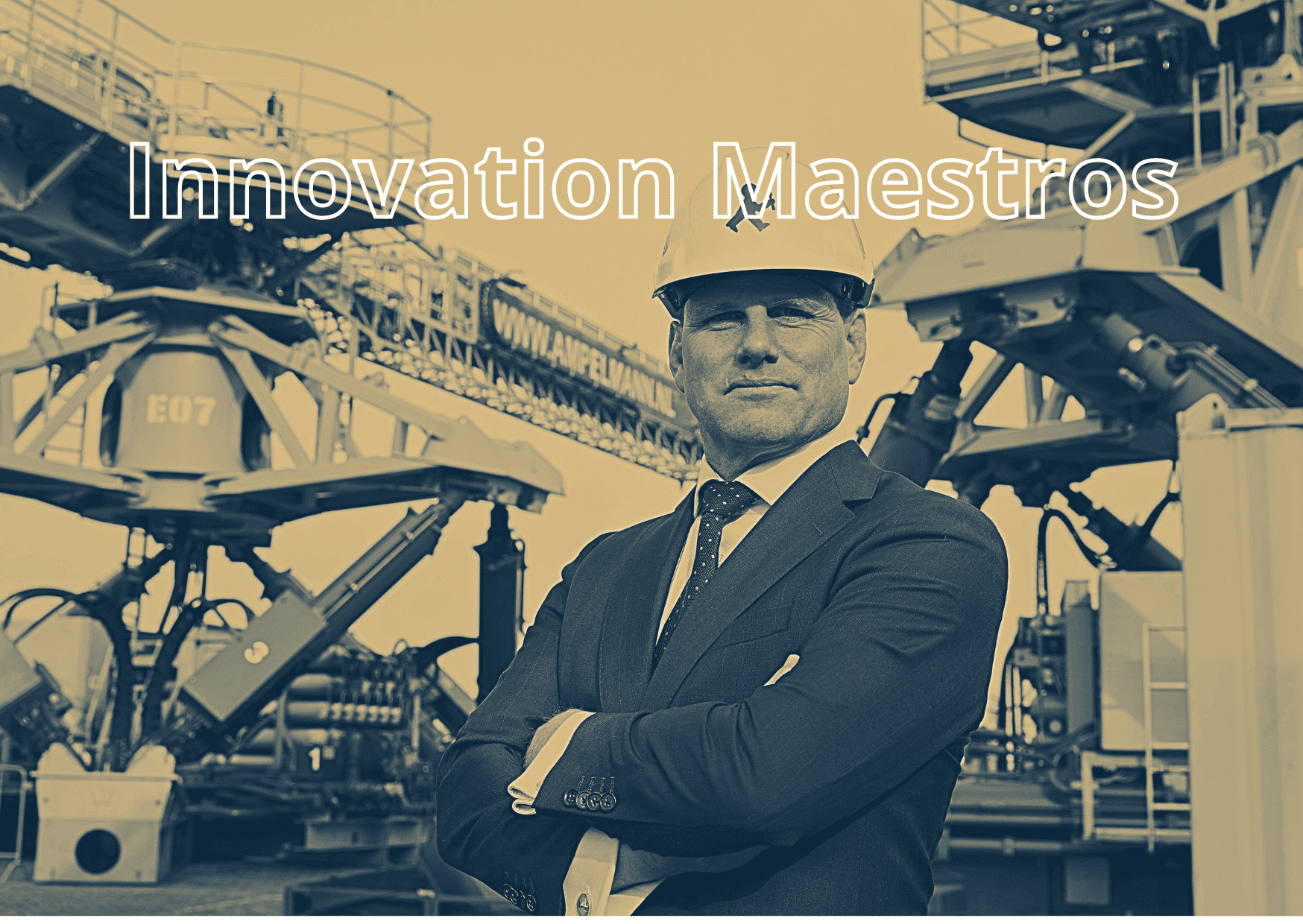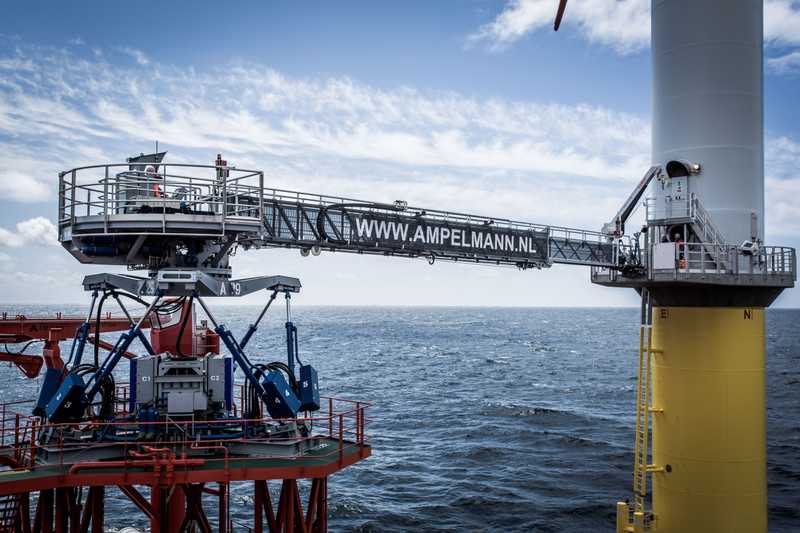
The world is moving towards a sustainable future. In this, offshore wind farms are indispensable: currently, offshore wind makes up 16% of the energy mix in the Netherlands. But if we want to build and maintain more wind farms, a safe way to switch to a wind turbine at sea is indispensable. Dutch engineer Jan van der Tempel’s special walkways offer a solution. At the North Pole, they operate in temperatures down to -40 degrees, and in Canada, they defy waves of 10 meters.
Why this is important:
If we want a green future, we must not only generate more renewable energy but address the entire infrastructure. In this regard, offshore walkways are indispensable.
As simple as crossing the street
Anyone who has ever been to Berlin knows about the Ampelmann: the little figure on pedestrian traffic lights. An iconic design from the GDR era, and also the name of the inventor’s company.
This is no coincidence. Van der Tempel, a TU Delft alumni, came up with the idea for his walkway during an offshore wind conference in Berlin. At the time, he was working on his doctoral research on wind turbine support structures. “That was in the summer of 2002,” he interjects. “Someone had prepared a story about a ship that was to provide access to a wind turbine, but the scale of the animation accompanying the story was incorrect due to a calculation error.” That led to many critical questions from the audience and also got Van der Tempel thinking. “Crossing over at sea, that’s quite an undertaking, and nobody had an efficient solution for it. Later, on the Biergarten terrace, I talked to a colleague, and it occurred to me, ‘Why don’t we apply the idea of an airplane simulator to a footbridge?’ That way it will be able to withstand high waves.” And so it happened. The concept for his company Ampelmann was born. “Offshore access is as easy as crossing the street. That is still our slogan.” Ampelmann has made a total of 75 footbridges. The company’s workforce numbers 400, “and we’re all over the world, from Houston to the North Pole.”
So the aircraft simulator formed the basis for the walkway. Here’s the thing: A simulator uses a six-legged structure to mimic movement, giving a pilot the feeling of flying. The Ampelmann walkway works similarly, but instead of mimicking movements, the walkway corrects a ship’s movements by making counter-movements. This keeps the walkway stable and allows workers to transfer safely.
A rowboat
After the idea popped, the would-be inventor quickly got to work. “We put some students together to work out the idea. They calculated the right sizes and speeds, and looked at which cylinders we could best use.” The conclusion: it should work. The first trial of a scale model took place in 2005. “We borrowed a floating platform from a company and bought a rowing boat on Marktplaats for €200,” he says. At the time, he had no idea that the rowing boat experiment would turn into a successful business. Yet that is exactly what happened.
More and more offshore wind farms
To achieve a carbon-free electricity system by 2050, offshore wind power is the main source of green power in the Netherlands. By 2030, offshore capacity must increase sevenfold to 21.5 GW. With the rise of offshore wind power, the inventor sees his company growing faster and faster. “Countries such as Japan and Taiwan, which until now have mainly depended on gas and oil, are going to be fully committed to this in the coming years.” And then they won’t escape the Ampelmann walking bridge.
Waves 10 meters high
There are different types of walkways, suitable for each climate. “In Brunei, around the equator, we face higher waves only during the monsoon. So these walkways are smaller.” He also created a variant for the Arctic. That can operate fine at temperatures of -40 °C. And a few years ago, Ampelmann conducted another test off the coast of Canada. This led to a design for a walkway that can withstand waves of up to 10 meters.

Lower costs and more sustainable
The walkway offers several advantages for offshore wind companies compared to traditional solutions. Instead of expensive and time-consuming helicopter flights, workers can easily transfer to offshore installations from the ship. In addition, ships can serve as “hotels,” making personnel and materials readily available on-site.
Ampelmann’s walkways are also sustainable, which is becoming increasingly important for companies due to climate goals and stricter regulations. The walkways are fully electric. Energy is consumed during the pushing out of the cylinder, but when the cylinder is lowered back, almost all of the energy is recovered.
The next chapter
The Delft inventor could have rested on his laurels after the success of the footbridge. With that alone, he would go down in history as a respected inventor. For example, he was nominated for the European Inventor Award in the industry category. “But taking a good idea to market is too much fun,” he smiles. “You have to get your idea on paper, be able to explain it, and test it. I see it as a challenging puzzle.” He is currently in the midst of his follow-up project: a hydraulic wind turbine. The current subject matter for offshore wind turbines is based on onshore wind turbines. This results in unnecessarily heavy structures and high maintenance costs. Since 2008, Van der Tempel has therefore been working with doctoral students and students on an innovative wind turbine: the Delft Offshore Turbine (DOT). Instead of traditional methods, individual turbines pump water to a central generation system to generate electricity. The top of the turbines are half as light as regular offshore wind turbines, and in addition to electricity, they can convert seawater into drinking water. Recently, the company announced that a test turbine will be shipped to Namibia. “The country’s president has declared a state of emergency because of the drought. So we can make a nice contribution in clean drinking water.”
Who knows what new inventions lie ahead, Van der Tempel adds in conclusion. “But that’s a story for another time.”

